Are you considering getting a tattoo that has a rich cultural history and deep symbolism? Look no further than the Japanese crane tattoo. Known for its grace, beauty, and longevity, this elegant bird has captured the hearts of people worldwide. In this article with Impeccable Nest, we’ll dive into the Japanese crane tattoo meaning, designs, and everything else you need to know before getting inked.
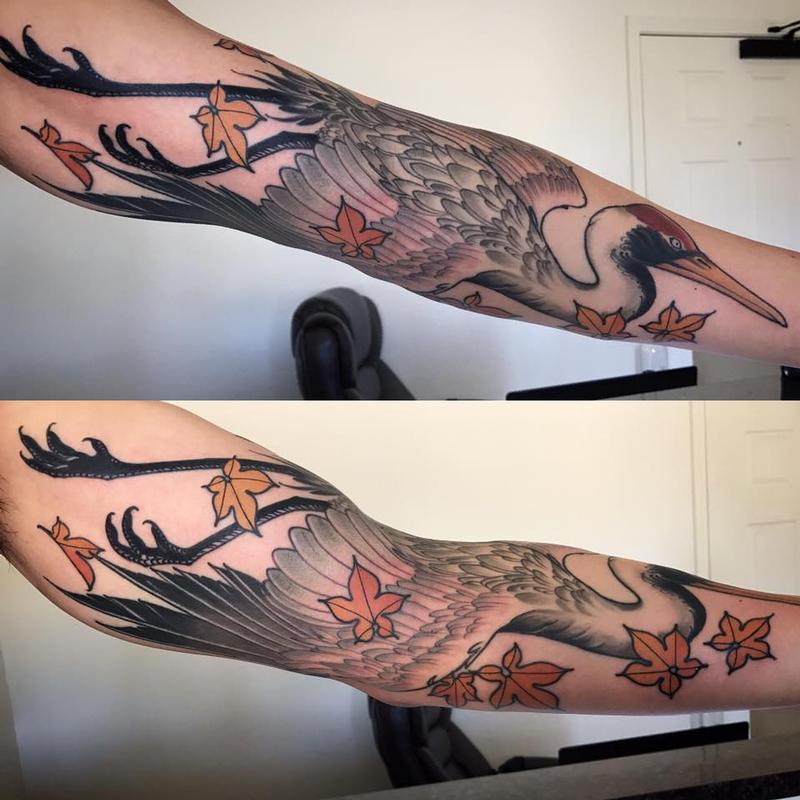
Japanese Crane Tattoo Meaning: Unlocking the Symbolism Behind
In Japanese culture, the crane holds significant symbolism and is a popular subject for tattoos. The crane is revered for its beauty, longevity, and symbolism in various aspects of life. Here are some common meanings associated with a Japanese crane tattoo:
Longevity and Good Fortune
The Japanese crane tattoo is a popular choice for those seeking a design that embodies cultural significance and symbolism. The crane, also known as “tsuru” in Japanese, holds a prominent place in Japanese folklore and mythology, symbolizing longevity, good fortune, prosperity, and happiness.
In Japan, the crane is believed to have a lifespan of a thousand years and is revered for its beauty, grace, and strength. It is also associated with the legend of the “Senbazuru,” which translates to “a thousand cranes.” According to this legend, folding a thousand origami cranes would grant someone’s wish or bring good luck and healing to a sick person.
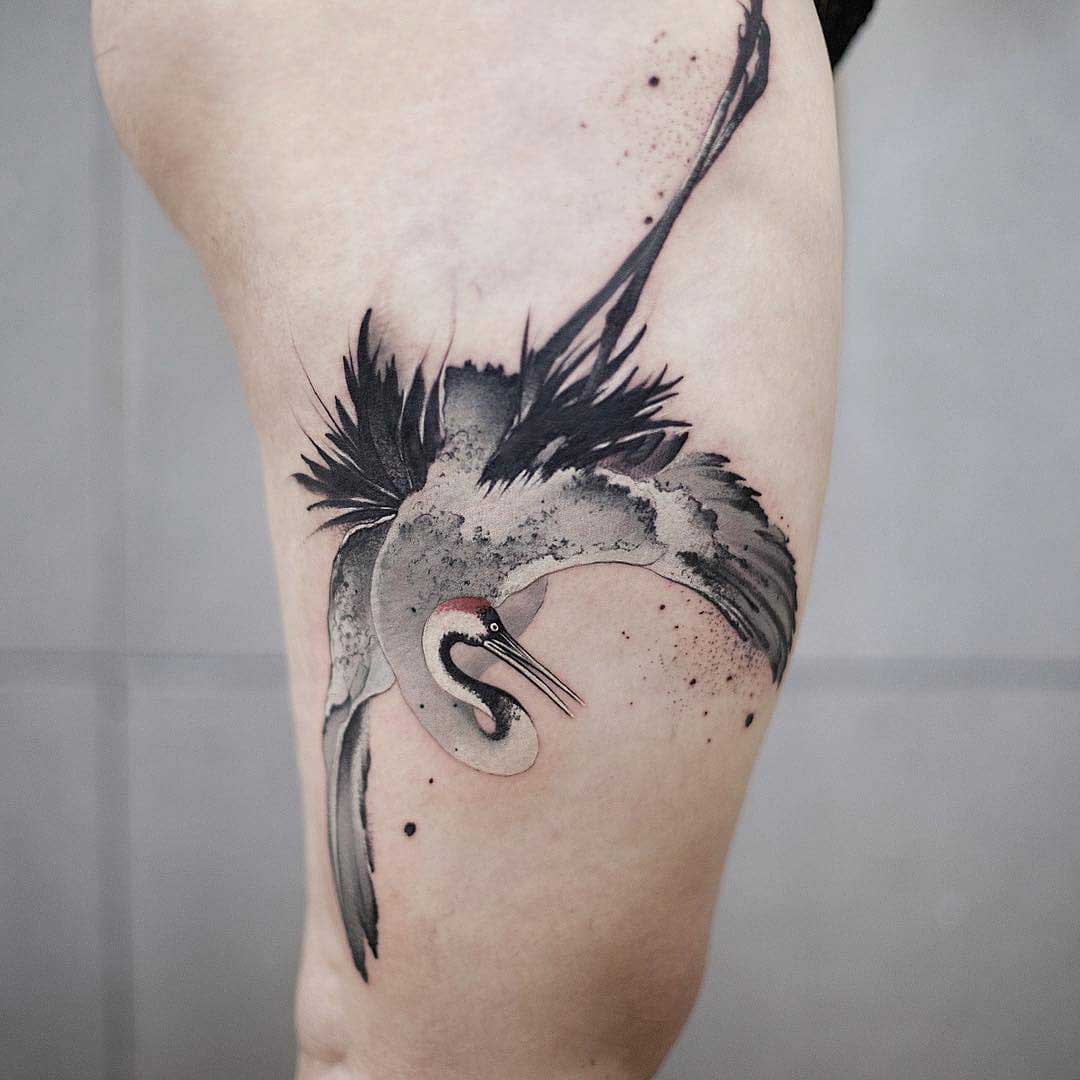
The symbolism of the crane extends beyond just good fortune and longevity. In Japanese culture, the crane represents fidelity, loyalty, and everlasting love. This association stems from the crane’s mating habits, where they mate for life and remain faithful to their partners until death. Thus, the crane tattoo can also be interpreted as a symbol of commitment and devotion.
The crane is also associated with the Japanese Shinto religion, where it is considered a sacred creature and believed to be a messenger of the gods. It is often featured in traditional Japanese artwork such as ukiyo-e prints, kabuki theater, and Noh plays.
When it comes to tattoo design, the crane can be depicted in various poses, each carrying its unique meaning. For example, a crane with its wings spread wide represents freedom, while a crane with a turtle symbolizes longevity and good health. A crane with cherry blossoms signifies beginning anew or new beginnings, whereas a crane in flight implies transcendence and spiritual elevation.
Overall, the Japanese crane tattoo is a beautiful and meaningful design that symbolizes longevity, good fortune, fidelity, and devotion. Its rich history, cultural significance, and artistic versatility make it an excellent choice for those seeking a tattoo that embodies deeper layers of meaning and symbolism.
Elegance and Grace
The Japanese Crane tattoo is a popular design that holds significant meaning in Japanese culture. The crane, also known as the “tsuru,” is considered a sacred bird in Japan, with strong symbolism of longevity, good fortune, and peace.
In Japanese mythology, cranes are believed to live for 1,000 years and possess the power of immortality. Therefore, a crane tattoo may represent a desire for a long and fulfilling life or a connection to one’s ancestors.
Moreover, the Japanese Crane is considered a symbol of good luck and prosperity due to its association with the legend of the “Senbazuru.” According to this legend, if a person folds 1,000 origami cranes, their wish will come true. This story became widely known after a young girl named Sadako Sasaki, who survived the atomic bombing of Hiroshima but later developed leukemia, attempted to fold 1,000 cranes in hopes of curing her illness.
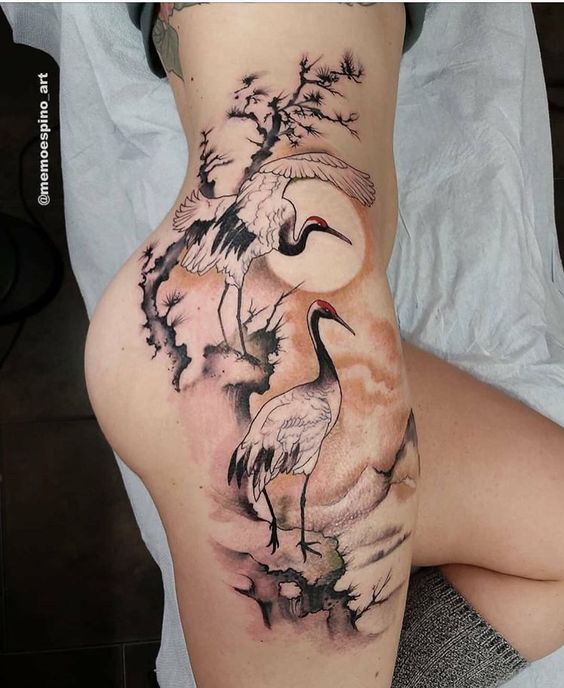
Furthermore, the graceful and elegant movements of the crane have made it a symbol of beauty, grace, and refinement in Japanese art and culture. Therefore, a crane tattoo could represent an appreciation for these qualities or a desire to embody them oneself.
Finally, the Japanese Crane tattoo can also hold spiritual significance. In Japanese Buddhism, the crane is seen as a messenger of the gods and a symbol of purity and enlightenment. Thus, a crane tattoo might represent a spiritual journey or a connection to the divine.
Overall, the Japanese Crane tattoo is a beautiful and meaningful design that can hold various interpretations depending on one’s personal beliefs and values.
Wisdom and Immortality
In Japanese culture, cranes have long been revered as wise creatures and are often viewed as symbols of good fortune, longevity, and happiness. The significance of the crane in Japanese mythology dates back centuries, with legends and stories featuring these majestic birds appearing in various forms.
One of the most well-known myths is that of the “thousand cranes,” which tells the story of a person who will be granted a wish if they fold one thousand paper cranes. The origami crane has since become a popular symbol of hope, healing, and peace, particularly in times of adversity.
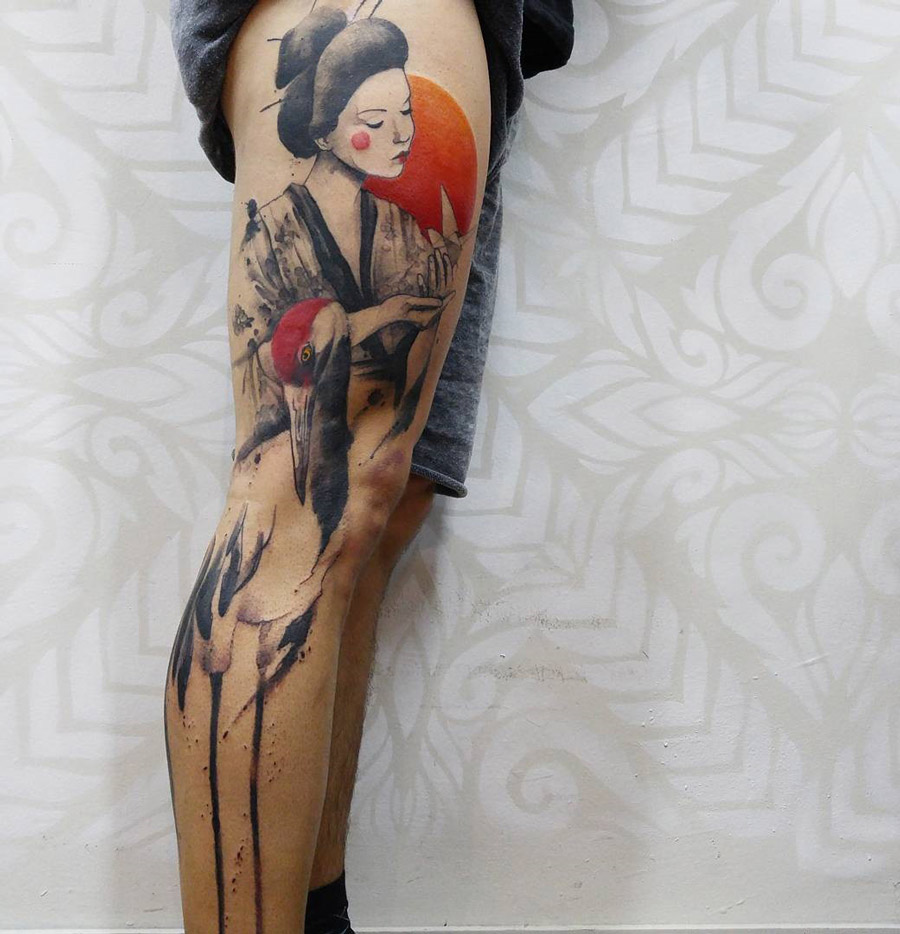

Furthermore, the crane is also associated with immortality due to its mythical connection to the realm of the spirits. According to legend, the crane was said to live for a thousand years, and anyone who folded the aforementioned thousand paper cranes would be granted a wish for eternal life.
With this in mind, a crane tattoo could hold a significant meaning for those seeking to pursue wisdom and transcend mortality. It could represent a desire to gain knowledge and insight, and perhaps even a willingness to embrace the inevitable cycle of birth, death, and rebirth.
Ultimately, the symbolism of a crane tattoo may vary from person to person, depending on their own beliefs and experiences. However, it remains a powerful and meaningful image that continues to inspire and captivate people around the world.
Resilience and Endurance
The Japanese crane, also known as the “red-crowned crane,” is a revered symbol in Japanese culture. It is known for its beauty, gracefulness, and longevity – with some cranes living up to 80 years. The crane has a rich history in Japanese folklore and mythology and is often associated with good fortune, longevity, and prosperity.
In Japanese art, the crane is commonly depicted flying or standing gracefully with its wings spread wide. This image is often captured in traditional Japanese paintings, calligraphy, and even folded into origami. In addition, the crane is featured in many Japanese legends and tales, including the story of Sadako Sasaki, a young girl who developed leukemia after being exposed to radiation from the atomic bomb dropped on Hiroshima during World War II. As she folded thousands of paper cranes in hopes of healing, the crane became a powerful symbol of peace and hope.
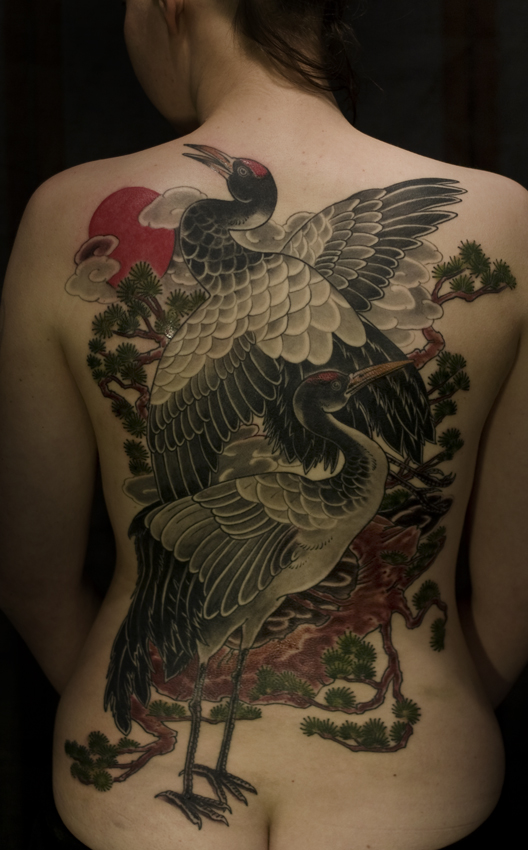
When it comes to tattoos, the Japanese crane is a popular design choice among both men and women. A crane tattoo can represent various meanings depending on the individual’s interpretation. Most notably, it can symbolize resilience and endurance. This is due to the bird’s ability to withstand long migrations and harsh weather conditions. The crane is also known for its strong pair bonding and the ability to live a long life, making it a powerful symbol of love and commitment.
In addition, the crane is often associated with good luck and prosperity. According to Japanese legend, anyone who folds 1,000 paper cranes will be granted a wish by the gods. Therefore, individuals may choose to incorporate this tradition into their tattoo design as a way to attract positive energy and blessings into their lives.
Overall, a Japanese crane tattoo is a beautiful and meaningful choice that can represent a variety of personal beliefs and values. Whether you choose to get a large or small design, the crane’s grace and elegance are sure to make a lasting impression.
Love and Fidelity
In Japanese culture, cranes are highly revered and symbolize a variety of positive attributes and emotions. One of the most common meanings associated with crane imagery is that of lifelong love and partnership. This is due to the fact that cranes are monogamous birds that mate for life, remaining devoted to their partners for many years.
As such, individuals who choose to get a crane tattoo may do so as a way to symbolize their own deep and lasting romantic relationship. The image of two cranes together represents a bond that is unbreakable, signifying the strength and loyalty of the love between two people. In Japan, cranes are often used as decorative motifs in weddings, and it is not uncommon to see crane imagery incorporated into traditional wedding attire.
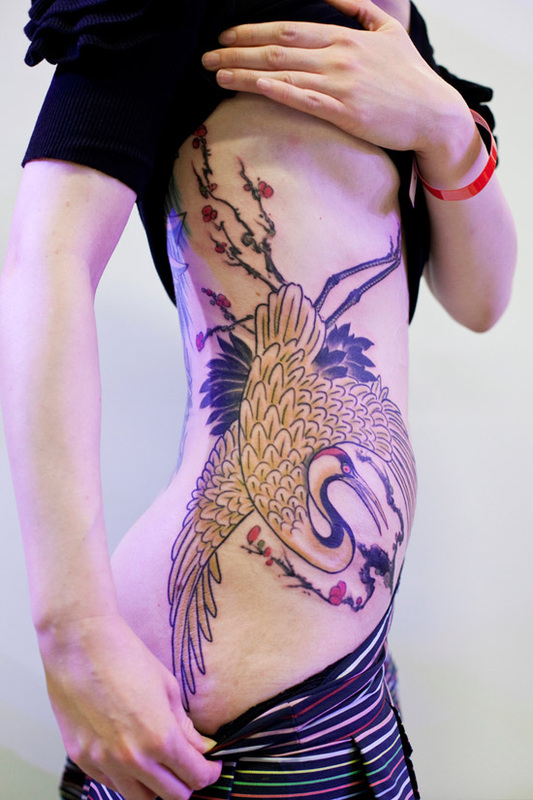
Aside from representing love and partnership, crane tattoos can also carry a variety of other meanings. For example, cranes are known for their elegance and gracefulness, and as such, they can be seen as symbols of beauty and refinement. Additionally, cranes are associated with good fortune and longevity, and are thought to bring blessings and good luck to those who are able to witness them.
In Japanese mythology, cranes are said to have mystical powers, and are sometimes depicted as messengers of the gods. As such, crane tattoos can also be seen as a representation of spirituality and faith. They may be chosen by individuals who feel a strong connection to nature or who are seeking guidance and support from a higher power.
Overall, crane tattoos carry a wealth of cultural and symbolic significance, and can be a powerful way to express one’s values, beliefs, and emotions through art. Whether chosen to represent love, beauty, good fortune, or spirituality, these tattoos serve as a tribute to the majesty and wonder of this magnificent bird.
Happiness and Tranquility
In Japanese art, cranes are often portrayed in serene and tranquil settings, which has led to the bird being associated with peace, happiness, and harmony. In traditional Japanese culture, the crane is considered a symbol of good fortune and longevity due to its graceful appearance and long lifespan. This association has made it a popular image in various forms of Japanese art, including tattoos.
A crane tattoo can be a powerful symbol of one’s personal pursuit of inner peace and happiness. Cranes are known for their calm and graceful demeanor, which can evoke feelings of tranquility and serenity when depicted in a tattoo. The use of vibrant colors and intricate designs can add to the beauty of the tattoo and emphasize the idea of a peaceful and harmonious life.
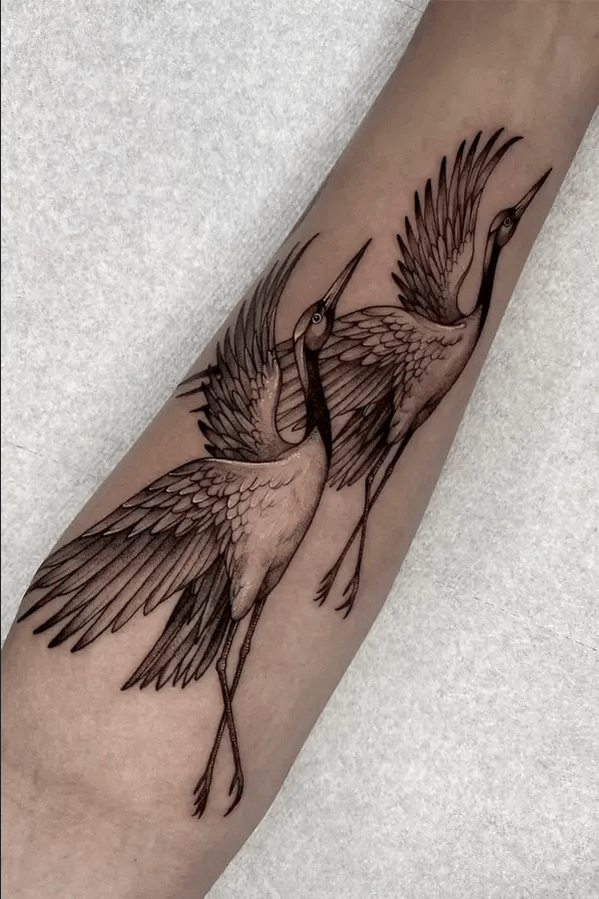
Additionally, the crane’s long lifespan is seen as a representation of resilience and perseverance. It is believed that the crane represents a person’s ability to overcome challenges and obstacles in order to achieve their goals. As such, a crane tattoo can serve as a reminder of one’s personal strength and determination to pursue their dreams and aspirations.
In conclusion, a crane tattoo in Japanese art can symbolize one’s pursuit of happiness, inner peace, and harmony. Through its association with good fortune, longevity, and resilience, a crane tattoo can serve as a powerful and meaningful symbol of personal growth and self-discovery.
New Beginnings
Cranes are known for their impressive and extensive migration patterns, which have been observed for centuries. These graceful birds fly thousands of miles each year, traveling from their breeding grounds in the northern hemisphere to warmer climates during the winter months.
One of the most famous crane species, the red-crowned crane, has a particularly special relationship with Japan. These birds were once widespread throughout East Asia, but due to habitat loss and hunting, their populations dwindled to just a few hundred individuals by the mid-20th century. However, through conservation efforts and protection, the red-crowned crane population has rebounded, and they continue to be strongly associated with Japan.
Each year, thousands of red-crowned cranes return to their breeding grounds in Hokkaido, the northernmost island of Japan. Their arrival is celebrated with festivals and ceremonies, as the cranes are seen as symbols of good luck, longevity, and fidelity. The annual return of the cranes also signifies a new beginning, as it marks the start of the breeding season and the continuation of the life cycle.
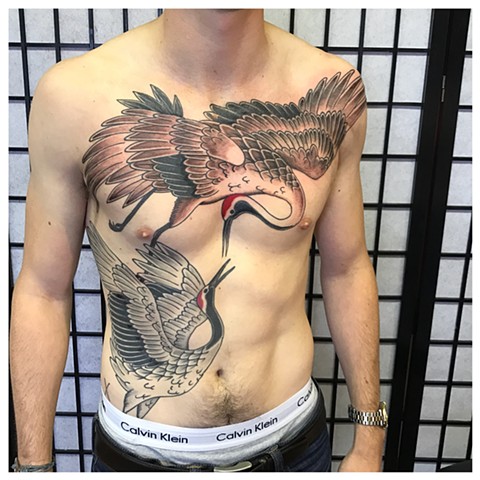
This connection between the crane’s migration patterns and new beginnings has led to the crane becoming a popular symbol in many cultures. In Japan, the crane is often depicted in art and literature, and its image can be found on everything from kimono to pottery. Similarly, in Chinese culture, cranes are believed to bring good fortune and prosperity, and are often depicted in traditional paintings.
One way that people choose to incorporate the crane’s symbolism into their own lives is through tattoos. A crane tattoo can represent many things, depending on the individual’s interpretation. For some, it may symbolize a fresh start or the opening of a new chapter in their life, much like the crane’s return to its breeding grounds. For others, it may represent long life, happiness, and good luck, as cranes are believed to bring these blessings in many cultures.
When considering a Japanese crane tattoo, it’s important to understand the depth of its symbolism and how it aligns with your personal values and experiences. Whether you choose a crane tattoo for its aesthetic beauty or its meaningful symbolism, take the time to reflect on what the image means to you and how it resonates with your identity.
Japanese Crane Tattoo Designs
Japanese crane tattoos come in various styles, each with its unique design and meaning. Here are some popular options:
Traditional Japanese Style
The traditional Japanese style (also known as Irezumi) features bold black outlines and vivid colors. This style depicts the crane in intricate detail, often surrounded by water, clouds, or sakura blossoms. The traditional Japanese crane tattoo represents good fortune, longevity, and prosperity.
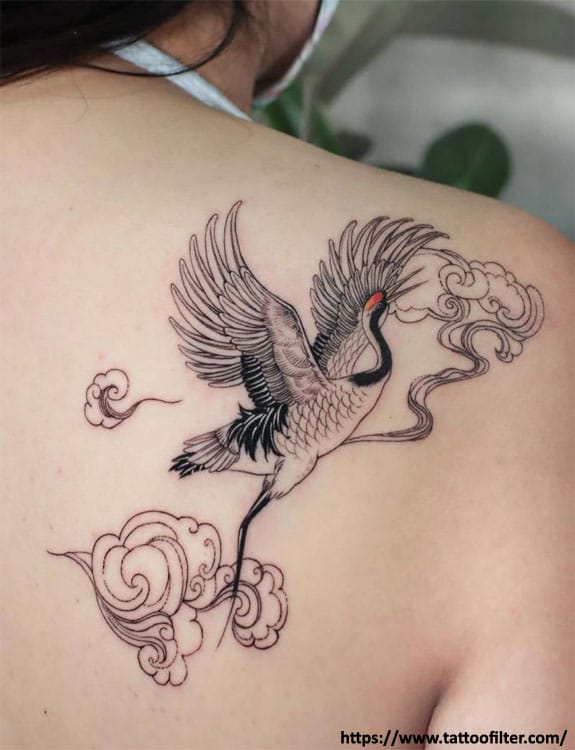
Minimalistic Style
For those who prefer a more subtle look, a minimalistic crane tattoo may suit your taste. These tattoos feature simple line work and negative space, resulting in a delicate, minimalist design. A tiny crane tattoo can be placed on the wrist, finger, or behind the ear, representing grace and elegance.
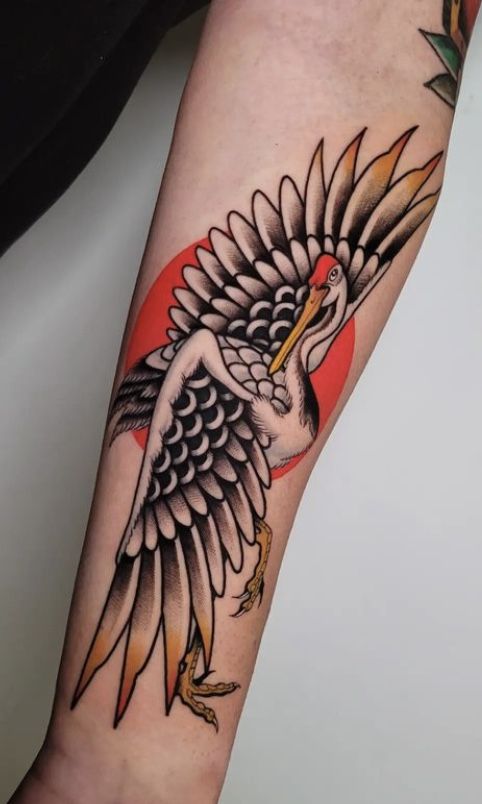
Realistic Style
If you’re looking for a more lifelike representation of the crane, a realistic style tattoo may be for you. These tattoos feature stunning detail, giving the impression that the bird could fly straight off your skin. A realistic Japanese crane tattoo represents beauty and grace.

Comparisons of Japanese Crane Tattoo Meaning
While the crane is a popular tattoo subject worldwide, the meaning behind it varies by culture. In China, the crane represents longevity and wisdom, while in Korea, it’s a symbol of peace and harmony. Meanwhile, Native American cultures see the crane as a messenger between humans and the spirit world.
However, the Japanese crane tattoo holds specific cultural significance and history, making it an excellent choice for those interested in Japanese art and mythology.
Conclusion
In conclusion, Japanese crane tattoos are a beautiful and meaningful choice for those interested in Japanese culture and symbolism. With their associations with longevity, good luck, and loyalty, they can serve as a reminder of positive qualities and values.
When considering a Japanese crane tattoo, it’s important to choose a design that speaks to you personally and work with an experienced tattoo artist. By taking proper care of your tattoo and respecting its cultural significance, you can enjoy a beautiful and meaningful piece of body art for years to come.

I am Harvey Berry, a tattoo enthusiast who has immersed himself in the diverse world of ink, passionately exploring the beauty and artistry within each tattoo. My mission extends beyond uncovering the aesthetics of tattooing; it involves sharing in-depth knowledge across all aspects of this art form.
Fueled by genuine curiosity and love for every facet of tattooing, I have diligently crafted well-researched articles, with a special focus on the Tattoo Meaning of Impeccable Nest section. Here, my aim is to help the tattoo community gain a deeper understanding of the meanings and values embedded in each tattoo.
One of my primary goals is to encourage responsible decision-making when it comes to getting inked. I recognize that choosing to get a tattoo is a significant personal decision that requires careful consideration. Hence, I provide diverse resources covering the meaning of tattoos, the tattooing process, aftercare tips, and other valuable information.
Whether you are a seasoned tattoo enthusiast or embarking on your first exploration of the world of body art, I aspire to be a reliable resource for you at every step of your journey. I hope that my extensive knowledge of tattoos, especially in the Tattoo Meaning section, will assist you in finding inspiration to express yourself through the art of tattoos.
